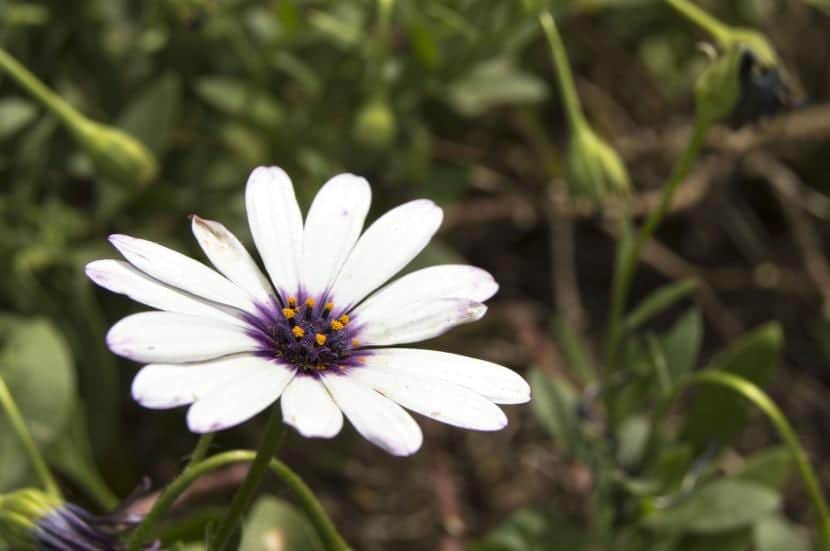
Dimorphotheca ecklonis
As global temperatures rise, rainfall becomes increasingly rare in many places. This change directly affects the gardens, which need more water to remain just as spectacular. Thus, It is highly recommended to choose those plants that best resist the lack of irrigation, since in this way we will save a few euros that never hurt 🙂.
There are many that you can choose from, but we have prepared for you one complete selection of drought resistant plants. We hope you find it useful.
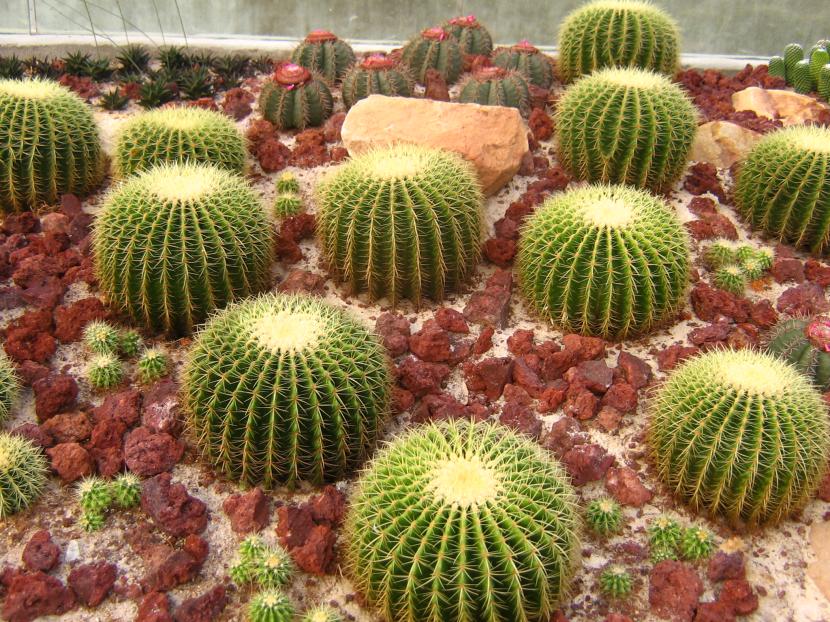
Echinocactus grusonii
Before getting into the subject, let's explain what a drought-resistant plant is. Well, these kinds of plants are those that have had to adapt to survive more or less long periods without water. There are some that, due to the extreme climatic conditions, have had to turn their leaves into thorns, such as cacti, or who have chosen to reduce their size, such as the olive tree, a tree native to the Mediterranean.
You can think, not without reason, that they are very easy to grow plants and that they do not require any type of maintenance, but the reality is that it is not entirely true. It is true that, in general, they are very resistant to pests, but At least during the first year that we have them planted in the ground, it is necessary to water so that the root system is strengthened. Nor will it hurt to pay occasionally so that development is optimal.
And, now yes, here is your guide:
Trees
Trees are the first type of plant to be found in a garden. Due to its size, it could be said that they are the »structure» of the place, on which our particular green paradise can be created. As we know, there are some that are fruity, and there are some that are ornamental. Let's look at them separately in more detail:
Ornamental
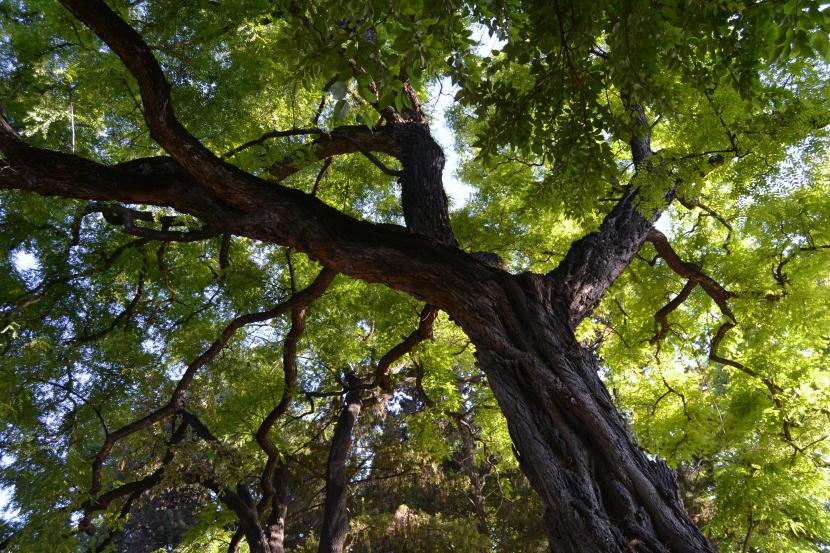
tipuana tipu
There are many ornamental trees capable of withstanding reasonably long periods of drought, and which also withstand some frosts soft. The most interesting species are:
- Brachychiton populneus: fast growing evergreen tree that reaches a height of about 10m. Withstands temperatures up to -4ºC.
- Fraxinus ornus: the ash is a beautiful tree that grows up to 20m. It has deciduous leaves, and supports cold temperatures down to -5ºC.
- Phytolacca dioica: the ombú is a perfect plant to have in large and warm gardens. Its leaves are evergreen, and it reaches a height of 8m.
- Ulmus sp. (all species): elm is a fast growing deciduous tree species very resistant to drought, and also to frost, since it supports up to -6ºC.
Fruit trees
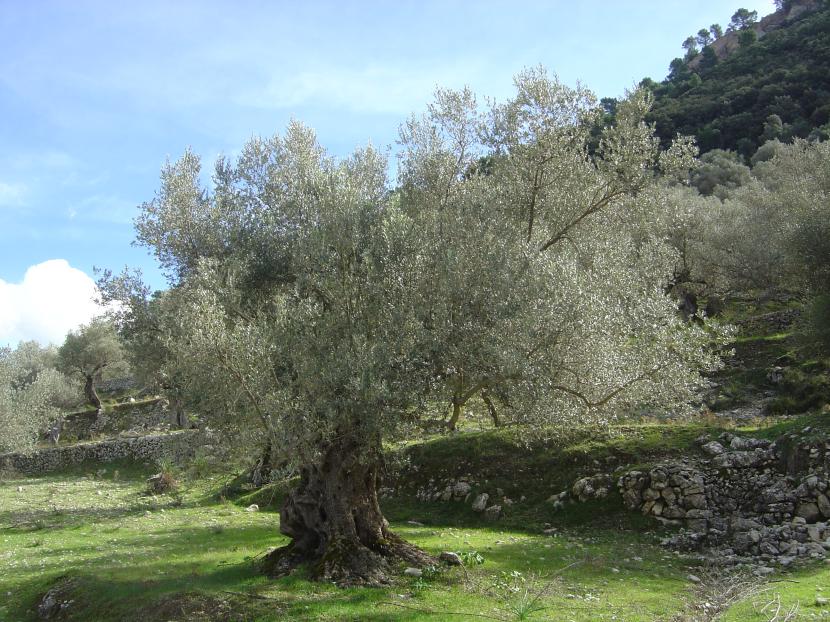
Olea europaea
Fruit trees, in general, prefer humid soils to be able to bear fruit properly. But if you live in a dry climate, there are some with which you will take more than one surprise. The most interesting are:
- Olea europaea: the olive tree reaches an approximate height of 6m. Its leaves are evergreen, so it will look pretty all year round. Supports up to -3ºC.
- Almond: the almond tree has deciduous leaves, and a rather slow growth rate. It grows to a height of 7m, and supports up to -3ºC.
- Punica granatum: the pomegranate is a deciduous tree that reaches a height of about 5-6m. Supports up to -4ºC.
- Eriobotrya japonica: the medlar is a very decorative plant. It is deciduous, and grows to 9-10m. It is rustic up to -4ºC.
Shrubbery
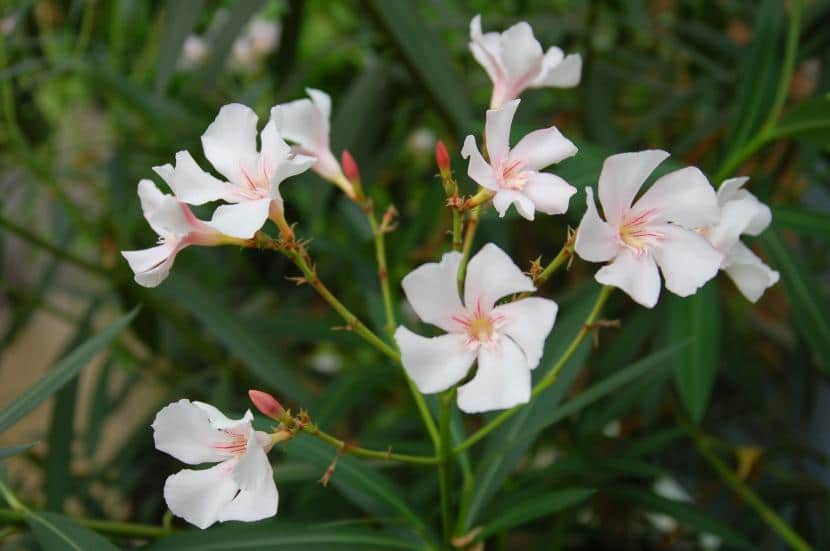
nerium oleander
The bushes will help us to fill spaces, adding color to the garden and, incidentally, attract pollinating insects thanks to its beautiful flowers. Do you want to know which are the most recommended? Take note:
- Buxus sp. (all species): boxwood is one of the most widely used plants for making hedges. It has an easily controllable growth, and also supports up to -5ºC.
- Cupressus sp.: cypresses turn out to be the best candidates to use both as isolated specimens and for hedges. They grow slowly, and can reach a height of 10m. They support up to -5ºC.
- Laurus nobilis: the laurel is a shrub or small evergreen tree that reaches a height of 4-5m. It is resistant up to -4ºC.
- nerium oleander: Oleander is an evergreen plant that reaches a height of 3m. Its flowers are very beautiful, but it is very important to prevent children and pets from approaching this plant, as it is toxic.
Cactus
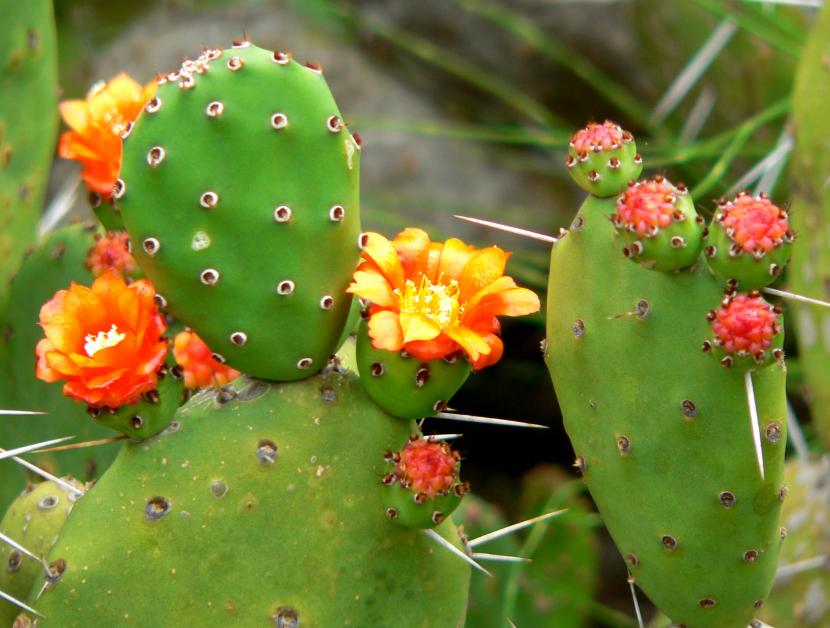
opuntia ovata
Cactaceous plants have always been the most recommended to have in gardens with a dry climate, although you should know that not all species will withstand more or less long periods without water as well once they reach adulthood. In fact, it is frequent that they have problems of lack of irrigation, and that is why it ends up being lost. So, from my own experience I can tell you that there are cacti that will actually grow reasonably well in xerogardens, and they are:
- Echinocactus sp. (all species): especially the Echinocactus grusonii, it is very decorative and resistant. It can reach one meter in height, with a thickness of 40cm. Resists cold down to -3ºC.
- Echinopsis sp. (all species): these plants are quite fast growing. They have very decorative flowers, and also resist the cold down to -3ºC.
- Opuntia sp. (all species): especially the Opuntia ficus-indica, these cacti have proven to be very adaptable. Very interesting to have in areas where the mercury in the thermometer drops to -4ºC.
Flowers

Gazania freezes
What better than to color the garden with some beautiful flowers. It is true that they are plants with high water needs, but I have good news for you: there are some species that are well adapted to living in dry places or where rainfall is scarce. In fact, some grow so fast and can take up so much space that it is advisable to prune them from time to time to keep them at bay. Do you want to know what they are? Are:
- Dimorphotheca sp (all species): these plants have a very fast growth rate. So much so that it is advisable to prune them every year. Its flowers can be white, lilac, orange or even red. They are perfect to cover spaces in a short time, since they also support up to -4ºC.
- Gazania freezes: Gazania are very curious little plants, since their flowers open only on sunny days. They support up to -3ºC.
- Rudbeckia spp. (all species): Rudbeckia are very ornamental. Its flowers are yellow or bicolor (yellow and red). They are rustic up to -4ºC.
- Chrysanthemum sp. (all species): chrysanthemums are really very decorative flowers, as there are many different varieties and colors (single flowers, double flowers, yellow, red, orange, bi-colors ...). Choose the one you like the most, and plant it in your xero-garden. By the way, they support up to -3ºC.
Palms
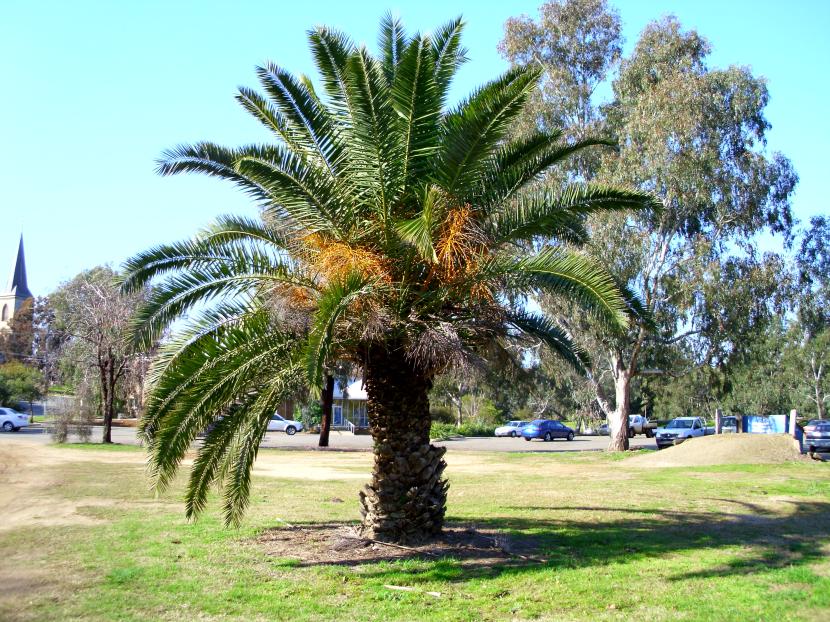
Phoenix canariensis
Palm trees, by many called the princesses of the garden, are plants with a singular beauty. All of them are very decorative, ideal to bring that tropical touch that we like so much. And it is that, who can avoid imagining lying between two copies? I at least not. So while they are moisture-loving, there are some species palm trees which will allow our dream to come true giving them just one watering or two a week. They are as follows:
- Chamaerops humilis: the heart of palm is a palm tree that grows to a height of about 3-4m. It supports cold temperatures, down to -4ºC without problem.
- phoenix sp. especially P. dactylifera and P. canariensis, these palms resist drought well once established. They reach a height of up to 10m, and support up to -6ºC.
- Trachycarpus fortunei: the raised palm is one of the palm tree species that best resists cold and drought. It grows to a height of 6m, and supports up to an incredible -10ºC.
- Washingtonia sp.: both W. robusta and W. filifera have proven to be highly resistant to drought. They reach a height of 10m, and resist the cold down to -5ºC.
Aromatic plants
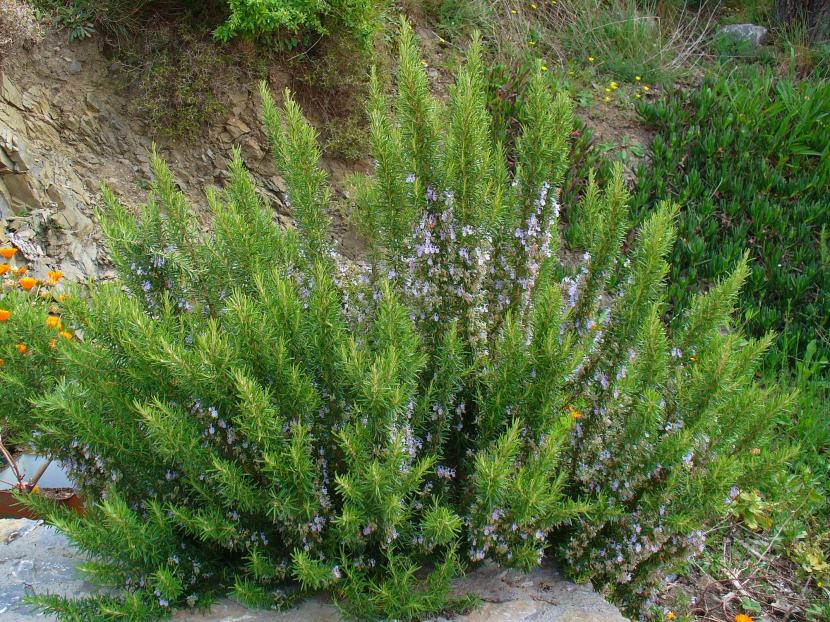
Rosmarinus officinalis
Aromatic plants cannot be missing in a garden. It is true that there are shrubs whose flowers smell really good, but ... if you want to aromatize, not only the garden, but also the home, there are a few species that you should take a look at:
- Lavandula sp. (all species): who does not know lavender? This beautiful plant will also help you repel mosquitoes. It grows to a height of about 40-50cm, and is perfect for marking paths or filling in spaces. Withstands cold down to -4ºC.
- Thymus vulgaris: thyme grows to approximately 40cm. Its extraordinary little whitish flowers will make that corner look and smell wonderful. Supports up to -3ºC.
- Rosmarinus officinalisRosemary is one of the best plants to have in low-maintenance gardens. With a height that can reach one meter, it supports all types of soils, and the cold down to -3ºC.
- Salvia officinalisSage is a very ornamental fast growing plant. With a height of about 40-50cm, they can be had in rockery along with other plants. They support up to -3ºC.
Succulents
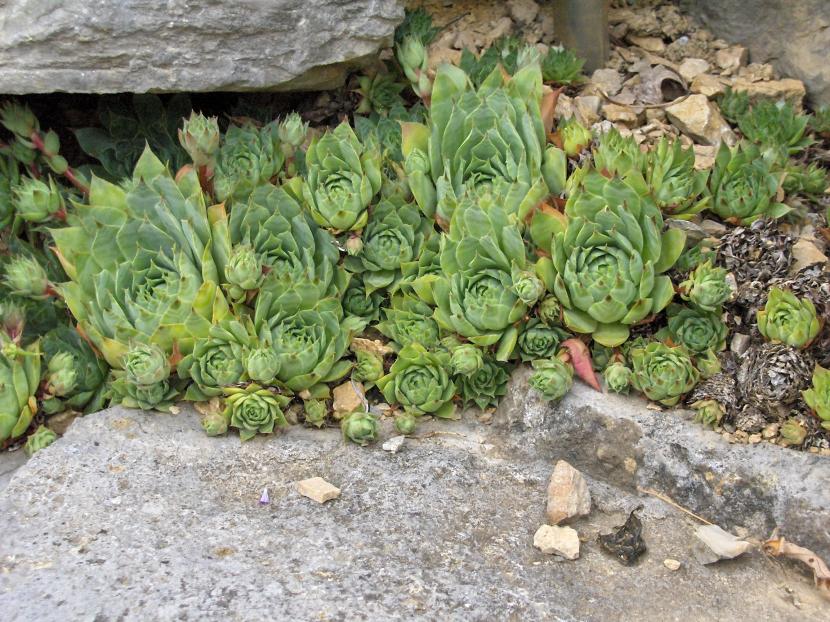
Sempervivum tectorum
Succulents are those that have their water reserves in leaves and / or stems. Most of them are native to the African continent, from places where rainfall is scarce and temperatures are warm, so that They turn out to be excellent little plants to have in xero-gardens, as for example in rockeries. Also, if you have very rocky terrain, put in a few succulents: they don't need a lot of soil to grow. The most interesting are:
- Agave sp. (all species): above all, the Agave americana can withstand long periods of drought without difficulty, as well as temperatures close to -3ºC.
- Crassula ovata: The Jade tree is a succulent shrub that grows up to 40-50cm in height. It is a curious plant that supports the cold down to -3ºC.
- Echeveria sp. (all species): echeveria have a high ornamental value. And they look like artificial flowers, don't you think? They resist well short periods of drought, and the cold up to -2ºC.
- Sempervivum tectorum: besides being very beautiful, exceptional for planting in very stony soils, it resists the cold without problems down to -4ºC.
Climbers
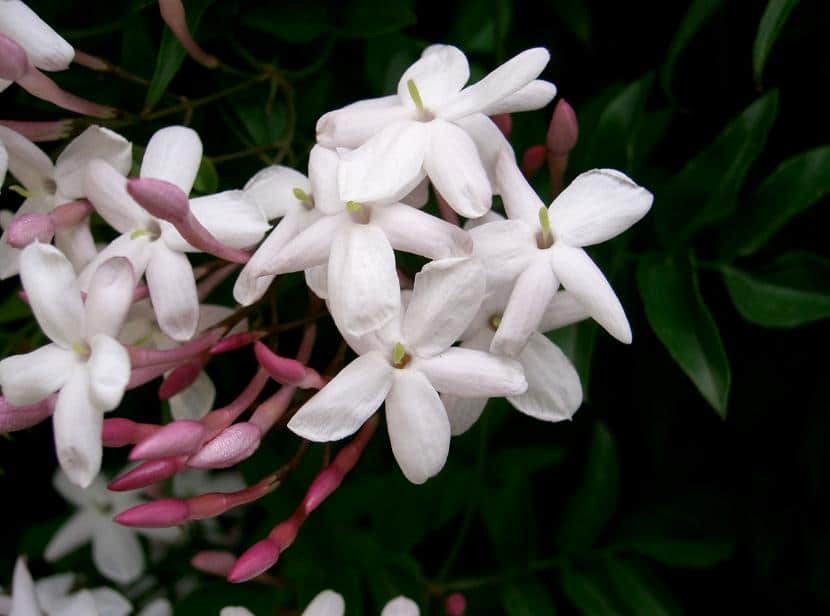
Jasminum polyanthum
If there is a wall that ugly the garden, it is time to put a climbing bush. Some species have flowers that, in addition to being very beautiful, give off a very pleasant aroma. Of course, you have to know that, in general, the climbers that resist drought have a rapid growth rate ... but that can be easily controlled by pruning work. Among all those that we find in nurseries, for low maintenance gardens we highlight the following:
- Jasminum sp. (all species): jasmine is widely used in gardening, especially to decorate small gardens. It is evergreen, and grows to a height of about 5-6m. Its beautiful white flowers give off a very pleasant aroma. Oh, and by the way, it resists the cold down to -4ºC.
- Bouganvillea sp. (all species): bougainvilleas are deciduous climbers whose bracts (which we easily mistake for their flowers) are red, white or orange. If you have to cover a wall, a lattice or a ceiling, it is your best candidate. Supports up to -3ºC.
- Tecomaria capensis: fast growing, its leaves are deciduous and it has very beautiful red-orange flowers. It is a climber that reaches 7m in height, and supports up to -4ºC.
- Passiflora caerulea: Passionflower is a very, very fast growing climber. It is very resistant, not only to drought, but also to cold, since it supports up to -5ºC.

And with this we are done. Enjoy your garden!
Excellence article. Thank you.
We're glad you like it, David. 🙂
very good information
We are glad you liked it 🙂
HELLO MONICA
Beautiful. How happy it is to know your work. I will continue visiting you.
Hello Lola.
Thank you for your words. We are glad that you like the blog 🙂
A greeting.
Excellent information. I'm going to use it on Margarita Island (Venezuela), if you have something else, please send it to me. Thank you very much and best regards.
Excellent information. I'm going to use it on Margarita Island (Venezuela), if you have something else, please send it to me. Thank you very much and best regards.
Hello Wenceslao.
We are glad that it is useful for you, but remember that each plant needs a specific climate and conditions; so it is very important to first make sure that they can live in your area.
If you have any questions, contact us.
Greetings.
If I am going to buy flowering plants so that they are inside my apartment, I would like to know the common names since these that you sometimes do not even know where they sell plants.
Thank you very much for your help in terms of green leaves, I will put it into practice, you are very well versed.
Hi Narda.
We always try to put, in addition to the scientific, common names since this way it is easier to recognize the plants. But if we do not put them, it is either because we do not know them or because there is not in Spanish 😉
For the rest, thanks to you for commenting! Greetings